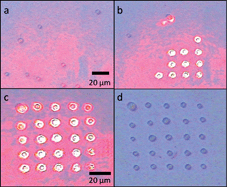Optoelectronic tweezers enables parallel manipulation of individual single cells using optical addressing and optically induced dielectrophoretic force. This provides a useful platform for performing a variety of biological functions, such as cell manipulation, cell sorting, and cell electroporation. However, in order to obtain more reliable cellular manipulation, especially of adherent mammalian cells, antifouling coatings need to be used to avoid non-specific cell adherence. Two antifouling coatings are discussed here, which can reduce the amount of non-specific adherence by as much as a factor of 30.
You have access to this article
 Please wait while we load your content...
Something went wrong. Try again?
Please wait while we load your content...
Something went wrong. Try again?


 Please wait while we load your content...
Please wait while we load your content...